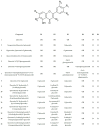Diplotaxis Genus: A Promising Source of Compounds with Nutritional and Biological Properties
- PMID: 38893488
- PMCID: PMC11173894
- DOI: 10.3390/molecules29112612
Diplotaxis Genus: A Promising Source of Compounds with Nutritional and Biological Properties
Abstract
Research on bioactive compounds is essential to improve human health; promote adequate nutrition; drive innovation in the food, agricultural and biotechnology industries; and contribute to the preservation of the environment. The genus Diplotaxis (Brassicaceae) currently comprises around forty species, some of which are edible, particularly Diplotaxis tenuifolia (wild rocket), Diplotaxis erucoides (wall rocket), Diplotaxis muralis (annual wall rocket), Diplotaxis viminea (perennial wall rocket), and Diplotaxis simplex. The leaves of these species are rich in fiber and essential minerals, such as calcium, iron, potassium, and magnesium. Thirteen species have been characterized for their phenolic compounds, predominantly kaempferol, quercetin, and isorhamnetin glycosides. Furthermore, glucosinolate compounds were identified in nineteen species of the genus Diplotaxis. Many of the phytochemicals identified in Diplotaxis spp. demonstrated interesting biological activities, such as antioxidant, anti-inflammatory, antibacterial, hypoglycemic and hypolipidemic effects, as well as cytotoxicity and antiproliferative properties. This article provides a review of the phytochemistry of the Diplotaxis genus, highlighting its importance in food, its biological properties, potential pharmacological applications, and the dearth of research on many of these plants.
Keywords: Brassicaceae; Diplotaxis genus; bioactive compounds; biological properties; nutritional properties.
Conflict of interest statement
The authors declare no conflicts of interest.
Figures





Similar articles
-
Ontogenic profiling of glucosinolates, flavonoids, and other secondary metabolites in Eruca sativa (salad rocket), Diplotaxis erucoides (wall rocket), Diplotaxis tenuifolia (wild rocket), and Bunias orientalis (Turkish rocket).J Agric Food Chem. 2006 May 31;54(11):4005-15. doi: 10.1021/jf052756t. J Agric Food Chem. 2006. PMID: 16719527
-
Identification and quantification of glucosinolate and flavonol compounds in rocket salad (Eruca sativa, Eruca vesicaria and Diplotaxis tenuifolia) by LC-MS: highlighting the potential for improving nutritional value of rocket crops.Food Chem. 2015 Apr 1;172:852-61. doi: 10.1016/j.foodchem.2014.09.116. Epub 2014 Sep 30. Food Chem. 2015. PMID: 25442630 Free PMC article.
-
Analysis of phytochemical composition and chemoprotective capacity of rocket (Eruca sativa and Diplotaxis tenuifolia) leafy salad following cultivation in different environments.J Agric Food Chem. 2009 Jun 24;57(12):5227-34. doi: 10.1021/jf9002973. J Agric Food Chem. 2009. PMID: 19489541
-
Glucosinolates, myrosinase hydrolysis products, and flavonols found in rocket (Eruca sativa and Diplotaxis tenuifolia).J Agric Food Chem. 2014 May 21;62(20):4481-92. doi: 10.1021/jf501096x. Epub 2014 May 8. J Agric Food Chem. 2014. PMID: 24773270 Review.
-
Biological, nutritional, and therapeutic significance of Moringa oleifera Lam.Phytother Res. 2019 Nov;33(11):2870-2903. doi: 10.1002/ptr.6475. Epub 2019 Aug 27. Phytother Res. 2019. PMID: 31453658 Review.
Cited by
-
Diplotaxis muralis as an Emerging Food Crop: Chemical Composition, Nutritional Profile and Antioxidant Activities.Plants (Basel). 2025 Mar 8;14(6):844. doi: 10.3390/plants14060844. Plants (Basel). 2025. PMID: 40265798 Free PMC article.
-
Impacts of Sulfur on Glucosinolate Metabolism: From Arabidopsis to Wild Brassicales.Plants (Basel). 2025 Jul 10;14(14):2129. doi: 10.3390/plants14142129. Plants (Basel). 2025. PMID: 40733366 Free PMC article. Review.
-
Pharmacological potential of bioactive compounds in Catharanthus roseus extract: A comprehensive review.Toxicol Rep. 2025 Mar 17;14:101998. doi: 10.1016/j.toxrep.2025.101998. eCollection 2025 Jun. Toxicol Rep. 2025. PMID: 40213418 Free PMC article. Review.
-
Effects of Mulch and Fertilization on the Quantity and Quality of Perennial Wall-Rocket (Diplotaxis tenuifolia).Plants (Basel). 2025 May 9;14(10):1421. doi: 10.3390/plants14101421. Plants (Basel). 2025. PMID: 40430986 Free PMC article.
References
-
- Kaur S., Das M. Functional Foods: An Overview. Food Sci. Biotechnol. 2011;20:861–875. doi: 10.1007/s10068-011-0121-7. - DOI
-
- Martirosyan D., Miller E. Bioactive Compounds: The Key to Functional Foods. Bioact. Compd. Health Dis. 2018;1:36–39. doi: 10.31989/bchd.v1i3.539. ISSN 2574-0334 (Online), ISSN 2769-2426 (Print) - DOI
-
- Mondal S., Soumya N.P.P., Mini S., Sivan S.K. Bioactive Compounds in Functional Food and Their Role as Therapeutics. Bioact. Compd. Health Dis. 2021;4:24–39. doi: 10.31989/bchd.v4i3.786. ISSN 2574-0334 (Online), ISSN 2769-2426 (Print) - DOI
-
- Christaki E., Bonos E., Giannenas I., Florou-Paneri P. Aromatic Plants as a Source of Bioactive Compounds. Agriculture. 2012;2:228–243. doi: 10.3390/agriculture2030228. - DOI
-
- Fernandes S.S., Coelho M.S., de las Mercedes Salas-Mellado M. Chapter 7—Bioactive Compounds as Ingredients of Functional Foods: Polyphenols, Carotenoids, Peptides From Animal and Plant Sources New. In: Campos M.R.S., editor. Bioactive Compounds. Woodhead Publishing; Sawston, UK: 2019. pp. 129–142.
Publication types
MeSH terms
Substances
LinkOut - more resources
Full Text Sources
Molecular Biology Databases
Miscellaneous

